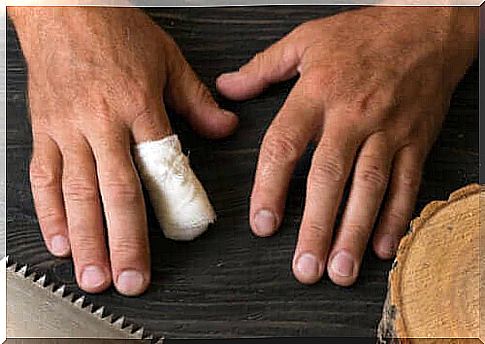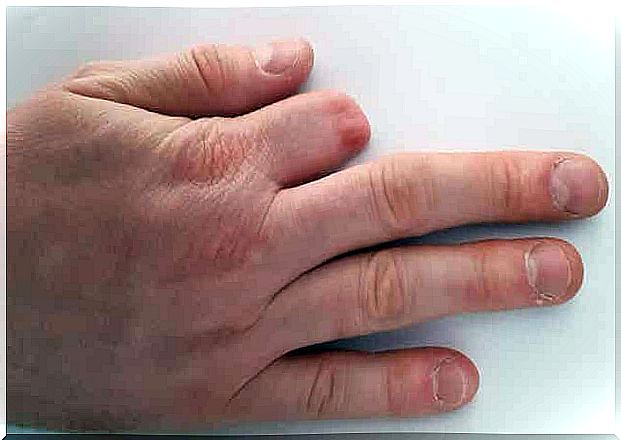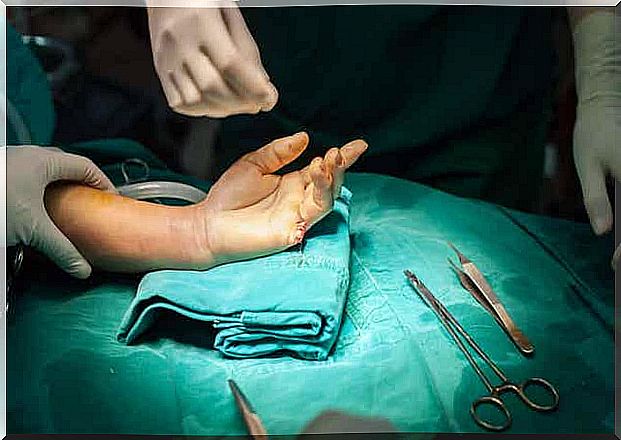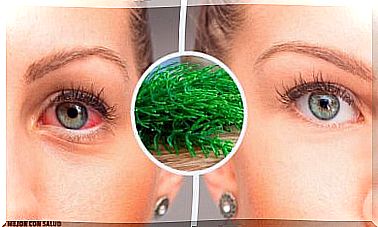Accidental Finger Amputation: First Aid

Involuntary amputation of a finger is a common situation in the emergency department. Most often this happens with the fingers, but it can also occur on the toes. There can be many reasons for this problem.
For example, industrial accidents, traffic accidents and accidents on farms are common. Finger amputation can also occur accidentally due to electric shock, burns or cold. In some cultures, this is done to punish criminals or as a ritual.
Few people know how to proceed properly when faced with such a situation. Therefore, in this article, we explain the most important first aid measures for the treatment of involuntary amputation. This will minimize the risk of losing your finger.
First aid for accidental finger amputation
According to a study at San Jose Hospital in Colombia, accidental finger amputation is one of the most common reasons for seeking emergency care. In fact, it is one of the most common emergency procedures in hand surgery.
This is an injury that needs to be treated quickly. The earlier and more effective the treatment, the more likely the detached part can be reattached. Therefore, the first step is to call the emergency number.
When calling an emergency number, it is necessary to explain the nature of the accident and the injury. A clean incision is not the same thing as a crushed limb. In addition, the emergency center will tell you what first aid measures you need to take.
1. Stop the bleeding
Once the emergency center has been contacted, the first step (which can also be done at the same time as the call) is to stop the bleeding. After involuntary finger amputation, bleeding is usually significant.
Try to stop the bleeding by pressing on the wound. At the same time, the injured arm should be raised above the heart. This makes it difficult for blood to flow in the direction of the hand.
However, experts do not recommend squeezing or tying the area too tightly. Too much pressure on any part of the limb can cause blood flow to be interrupted. This is detrimental to the finger as it becomes ischemic and is no longer viable for reconstruction.

2. Calm the patient
An article by Dr. Leopoldo Cagigal states that calming the injured person is the second most important task in the event of an accident. Involuntary finger amputation causes a lot of pain and can even lead to shock.
Therefore, doctors recommend placing the person in a supine position. Ideally, his legs should be raised to avoid dizziness. Similarly, experts advise keeping a person warm with a blanket or clothing. You should try to talk to him, reassure him and assure you that everything is fine.
Giving alcoholic beverages or food comes to mind for many. However, you should not do this. In fact, doctors suggest that a person should not eat or drink anything because surgical procedures will be performed in the next few hours.
3. Amputated finger care
There are many myths about what to do with an accidental finger amputation. In movies and series, this scene is very common, but many of the actions shown do not apply in real life.
An article from the American Academy of Orthopedic Surgeons briefly explains what you should do. First, you need to clean the wound, preferably with sterile gauze. Do not remove rings or patient clothing. Doctors also do not recommend rubbing the area.
After cleaning the amputated finger, it should be covered with wet gauze. In addition, all parts of the amputated finger must be preserved, no matter how small they are. Once this is done, place the amputated finger in a clean waterproof bag and seal it hermetically.
If more than one finger is detached, they should be placed in separate bags. Place these bags in a larger bag with ice. Ideally, you should keep your finger at a temperature of about 4 degrees Celsius.
Hospitalization in inadvertent finger amputation
As we have seen, calling an emergency center is paramount in an unintentional finger amputation.
In a hospital, the main goal is to stabilize the patient’s vital functions. The doctor then examines the hand and finger. Doctors can then find out if the finger can be reattached.
In any case, doctors will prescribe an anesthetic to heal the wound. The wound must be thoroughly cleaned to remove any remaining damaged tissue.
The last point is usually surgery to either reconstruct the finger or close the wound. A study published in the Journal of the Andalusian Society of Traumatology and Orthopedics states that the use of semi-permeable dressings helps healing to occur in a short period of time.
When is it not recommended to reattach an amputated finger?
There are many reasons why doctors may not recommend reinserting an amputated finger. One of them is if the injury is very complicated and the hand is not in good condition. For example, if it is crushed. Another reason is that the parts are not stored well.
In addition, physicians must consider the patient’s health. There are certain aspects, such as age, smoking, or diabetes, that have a negative effect on finger replanting.

Finger attachment
In this situation, many considerations need to be taken into account to assess whether a finger can be reattached. According to the Navarre Health Service, the finger should not be in an ischemic state for more than 6 hours.
Experts recommend attaching your thumb whenever possible. Especially in children. On the other hand, adhesion is more likely if the incision has been clean-edged.
Regression
After accidental finger amputation, the recovery process can be lengthy. Most people need rehabilitation to maintain hand movement. It all depends on what kind of injury it was.
Practicing your hand is really important. For example, you can open your fingers gradually. To do this, doctors recommend placing your hand on the table and lifting each finger gently. The patient must also bend it gradually.
Involuntary finger amputation: it is important to act quickly
If your finger comes off in an accident, for example, it is important to act quickly. You need to keep in mind to stop the bleeding without interrupting the blood flow.
Also, be sure to keep all loose parts. You can use clean bags and add ice to them.
However, the most important thing is to always call for help and get to the hospital as soon as possible.









